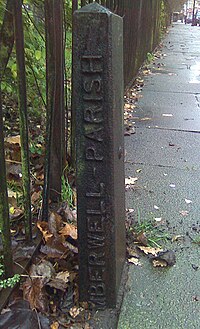River Effra: Difference between revisions
mNo edit summary |
|||
| Line 1: | Line 1: | ||
[[File:Effra vauxhall 1.jpg|thumb|right|Outflow of the River Effra into the Thames, by Vauxhall Bridge, beneath Alfred Drury's sculpture of ''Science'']] | [[File:Effra vauxhall 1.jpg|thumb|right|300px|Outflow of the River Effra into the Thames, by Vauxhall Bridge, beneath Alfred Drury's sculpture of ''Science'']] | ||
[[File:CambCamberwellParishBoundaryMarker.jpg|thumbnail|right| | [[File:CambCamberwellParishBoundaryMarker.jpg|thumbnail|right|200px|Boundary marker for Camberwell Parish on the route of the Effra at Gipsy Hill, where the river was rediscovered in the 1920s]] | ||
The '''River Effra''' is a river in northern [[Surrey]] which is now mainly underground. The name is derived from the Celtic word for torrent (''cf.'' 'ffrydlif' in current Welsh) given by the pre-Roman tribes.<ref>'The Thames' by Peter Akroyd</ref> or the name of a farm in Brixton. | The '''River Effra''' is a river in northern [[Surrey]] which is now mainly underground. The name is derived from the Celtic word for torrent (''cf.'' 'ffrydlif' in current Welsh) given by the pre-Roman tribes.<ref>'The Thames' by Peter Akroyd</ref> or the name of a farm in Brixton. | ||
Latest revision as of 12:57, 18 June 2014


The River Effra is a river in northern Surrey which is now mainly underground. The name is derived from the Celtic word for torrent (cf. 'ffrydlif' in current Welsh) given by the pre-Roman tribes.[1] or the name of a farm in Brixton.
When the London sewerage system was constructed during the mid-19th century, its designer Sir Joseph Bazalgette incorporated flows from the River Effra into his 'high-level interceptor sewer', also known as the Effra sewer, running from Herne Hill eastwards under Peckham and New Cross to Deptford.
The main course of the River Effra was diverted into a sewer and culverts. It can be accessed through the sewers on Effra Road in Brixton[2], South London and through a drainage grate in the crypts under St Luke's Church, West Norwood.
The route of the Effra
One branch of the Effra rises near Harold Road in Upper Norwood Recreation Ground, Crystal Palace, and flows through West Norwood where it is joined by a local tributary.
A second branch flows into West Dulwich alongside Gipsy Hill, which it joins at a junction with Dulwich Wood Avenue, after flowing downhill from near the Westow House pub at the eastern end of Westow Hill by way of Jasper Passage and the lower end of Colby Road. After picking up a tributary at Hamilton Road beyond The Mansion Pub at the junction where Gipsy Road, Alleyn Park and Gipsy Hill meet, this route meanders under Clive Road in the far West of West Dulwich. It eventually joins the other branch near where the South Circular and Croxted Road now pass. One channel of the river rose again briefly in Belair Park to Burbage Road and then under again to Half Moon Lane in North Dulwich. An alternative route north from the South Circular was a meandering stream on the other side of the railway along the eastern side of another hill where a section of Croxted Road was at the time named Croxted Lane and meandered with it.
At Half Moon Lane the Effra then works its way back towards Herne Hill railway station where it is joined by another tributary that flows through Leigham Vale, Tulse Hill and Brockwell Park. On John Rocque's map of 1745, this area around Herne Hill station is called 'Island Green', reflecting old routes of the Effra.
From Dulwich the river follows the line of the northern edge of Brockwell Park in Herne Hill and is joined by another tributary near Brixton's Effra Road, whose source is in the park, and thence flows under Brixton's Coldharbour Lane towards the Police Station at Brixton Road. It then follows the road towards Kennington before emptying into the River Thames near Vauxhall Bridge.
Flooding
Although little more than a stream in the south, until 1935 the encased watercourse flooded during heavy rains every decade or so; an inscription on a white stone tablet high up the side of a building in Elder Road, West Norwood reads: "FLOOD LEVEL 17th July 1890".
After a three hour long storm on Sunday 14 June 1914 the sewer overflowed again and flooded houses along its path from Elder Road to Chestnut Road, and locals were forced to evacuate their homes for several days. Further floods in the 1920s prompted works to enlarge the sewer. This was sufficient until the local area was flooded again during a powerful downpour in 2007 on July 20.
'Unearthing the Effra'
In 1992 a project by the London arts group Platform sparked a local campaign to dig up the river. The 'Unearthing the Effra' project was based around a mock 'Effra Redevelopment Agency', which included a public office. The project gained publicity in local newspapers and radio stations before the journalists noticed that the group had scattered, the whole thing being a stunt carried out in the name of art.
References
- ↑ 'The Thames' by Peter Akroyd
- ↑ http://www.28dayslater.co.uk/forums/showthread.php?s=c78863bd3cc87238374d3acc71d359fd&t=12524
J.B. Wilson & H.A. WIlson The Story of Norwood ISBN 0951538411
Referred to in John Constantine Hellblazer 239 as a passage to another world
Outside links
- Walking the River Effra
- Platform's Unearthing the Effra project.
- Photographs of the buried River Effra
- Ideal Homes River Effra
- Ideal homes Flood in Wood Street, West Norwood, 1914